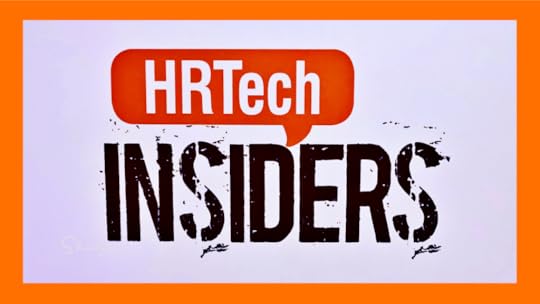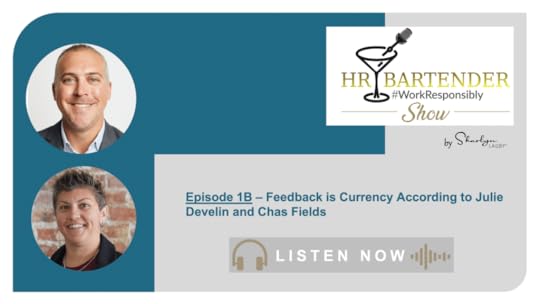Sharlyn J. Lauby's Blog, page 61
November 2, 2021
5 Ways Managers Can Support Working Parents

Estimated reading time: 5 minutes
(Editor’s Note: Today’s article is brought to you by our friends at Circle In , a global employee engagement platform focused on building a better working world for families and caregivers. Check out their recent guide on “ The Future of Work: The Importance of Flexible Workplaces ”. Enjoy the read!)
For working parents, having a supportive manager is essential to overcoming some of the challenges faced in the workplace. This is supported in research conducted by global engagement platform Circle In, who found that 68% of respondents said the flexibility they have is dependent on who their manager is. However, the same research also shows that most managers do not believe they are being unsupportive.
So, the purpose here isn’t to bash managers. Instead, it’s to offer some ways for organizations to give managers the tools they need to offer caregiving support whether it’s for working parents or eldercare.
Over the past year, we’ve spent a lot of time talking about how the pandemic has changed work. But it’s also changed our personal and family lives. Especially if you’re a parent. About half of employed parents (52%) say it’s been difficult to handle childcare responsibilities during the coronavirus outbreak, according to Pew Research. In addition, we’re hearing that childcare is an obstacle to employees returning to the office.
I get it. Managers, like their employees, are exhausted from COVID. But this doesn’t mean we can ignore the disconnect. Managers must provide employee support on top of everything else they are juggling. It’s hard. And organizations rely on managers to get it done.
So, the purpose here isn’t to bash managers. Instead, it’s to offer some ways for organizations to give managers the tools they need to offer caregiving support whether it’s for working parents or eldercare. And this is where a platform like Circle In can help. It’s an employee benefit platform that provides guided support for managers, enabling them to lead with empathy and confidence.
Give Managers the Tools to Support Working ParentsOrganizations need to recognize that our definitions of family are changing and what that means for our employees and their caregiving responsibilities. Here are five things that Circle In suggests organizations consider when helping managers support working parents:
Establish expectations with the management team. Organizations ask managers to set expectations with employees. That means the organization needs to set expectations with managers as well. Learning something new takes time and can be challenging. Some managers might say that they’re simply too busy and don’t have time. But ultimately, they need to be held accountable because a poor employee experience translates into increased turnover and decreased productivity.Acknowledge any biases or preconceived notions about working from home, remote work, and/or hybrid work…and eliminate them. The work environment must be equitable for all. In the past, managers might have relied on sight to evaluate employee performance. Today, organizations need to provide manager training on how to measure outcomes, not hours. Strike a balance between flexibility and structure. While we’re still in the pandemic, organizations need to think beyond it. Our work, school, and home life have become very intertwined. Working parents are not only expected to continue to execute work responsibilities, but do it while simultaneously being a teacher and parent. To provide support in a timely fashion, managers need to be equipped with practical tools and resources that they can consume and use in bite sized snippets 24/7.Show empathy towards the team and their needs. 53% of parents believe their manager could be doing more to support them through parental leave. Unfortunately, managers often don’t know what to say, so the default is for them to say nothing. This hurts the relationship with an employee. Instead of side-stepping difficult or awkward conversations, organizations should include learning how to navigate these conversations a part of manager training.Put trust in trust. Sometimes caregiving conversations need to be discreet. The subject matter could be something highly personal. For example, consider how a manager would support an employee who has suffered a stillbirth or an employee experiencing menopause. It’s possible that a manager would not feel comfortable or able to ask HR for help in navigating such an unknown conversation, but we still want the manager to receive the resources they need. Supporting Parents Benefits the OrganizationThere’s one more thing that I want to add to the last point about “putting trust in trust”. And that’s when we talk about trust, we don’t always need to have all the answers ourselves. We can find an outside expert that we trust to help. This is an opportunity for us as human resources professionals to demonstrate the value of leaving some topics to the experts. Role modeling is very effective when it’s visible and consistent.

If your organization wants to equip managers with the tools and resources to better support working parents, check out what Circle In has to offer in this archived webinar on “How Culture Amp enhanced support for working parents and caregivers”. Powered by AI and machine learning, Circle In delivers hyper-personalized workflows, experiences, and resources to make the demands of life easier for caregivers and managers both at home and at work.
The post 5 Ways Managers Can Support Working Parents appeared first on hr bartender.






October 31, 2021
Recruiting: 5 Ways to Get More Candidate Interviews

Estimated reading time: 3 minutes
By now, you’ve probably seen the article about the person in Florida who applied for two jobs every day for a month only to have just one interview. That’s not a typo – 60 applications got him one interview. And he didn’t apply for anything that required a degree or a lot of previous experience. He said that he started this “experiment” after hearing all of the comments about how “people just don’t want to work anymore”.
Today’s article isn’t a debate about whether people don’t want to work. And it’s not about whether what happened to this person is representative of the entire job market.
But there is something to pull from these conversations about recruiting and hiring. Organizations that really truly want to hire employees – and get completely staffed so they can take care of customers – need to look at their hiring processes and make sure they work.
It sounds so basic, but you can’t hire employees if you don’t interview candidates. Here are some things to consider when looking at your hiring process.
Make it easy for people to apply. There are so many ways to do this when recruiting. Two that immediately come to mind are 1) Make your application process mobile friendly. According to Pew Research, most Americans have a smartphone, which would allow someone to apply the moment they see the opening. And 2) make your employment application only as long as it needs to be. Organizations can ask candidates to complete a longer application later in the process.
Accommodate schedules. Let’s say you identify a candidate that you want to interview. But you’re busy and don’t have time for phone tag to set up a meeting. Technologies exist that allow applicants to schedule an interview online. Just send them a note and tell them you’d like to chat with them. Then ask them to pick a date on your schedule. Since they chose the date and time of the meeting, it reduces the chance of ghosting.
Be transparent about your recruiting process. You know your hiring process. Be upfront with candidates. Let them know how long it will take and what it will involve. Tell them why the process works for your organization and sets new hires up for success. If candidates understand the process, they might be more engaged with it. And that benefits the company and the candidate.
Stay in touch. One of the biggest complaints that I hear from candidates is that they went in for the interview, had a good conversation, and the company said they would call in a week. Three weeks have passed and no communication. Many candidates assume that no news is bad news and they start looking elsewhere. Find a way to keep candidates in the loop. If the company needs more time – tell them. If they’re no longer being considered, tell them.
Keep the door open. It’s very possible that your recruiting process will result in more than one qualified candidate. What a great position to be in! It’s also tough because both candidates are very qualified, and you can only hire one. That doesn’t mean you can’t ask the other candidate to stay in touch in case you have another opening. Or a different position that they would be equally qualified for. The point is making a final decision doesn’t have to close doors.
Organizations that are serious about hiring the best employees are working hard to create a hiring process that is easy for people to apply, interview, and get the job. That doesn’t mean the company has to compromise their standards. Just take a critical look at your hiring process and make sure it’s not the obstacle to success.
Image captured by Sharlyn Lauby while exploring the spooky streets of Austin, TX
The post Recruiting: 5 Ways to Get More Candidate Interviews appeared first on hr bartender.






October 28, 2021
Organizations and Employees Should Consider Mediation to Resolve Conflicts

Estimated reading time: 7 minutes
Conflict is a part of life. I know we don’t always like talking about it, but that doesn’t change the fact that we have to be able to regularly deal with conflict. And the way we manage conflict in our personal lives might be different from the way we handle it professionally.
I like to think of conflict in sort of 3-levels. The first level is when you’re upset, angry, or frustrated about something but you know it’s temporary and you’ll eventually get over it. At level two, this isn’t a conflict that’s simply going to “go away” and you will speak to someone about what’s on your mind. Sometimes the conflict is resolved and sometimes it’s not. Which leads us to the final level of conflict. At this level, we know that we need to take action to resolve the conflict, which often involves getting a third party involved.
That leads us to today’s article. When we’re frustrated, angry, disappointed in a situation and looking to take action, one of the first things we might consider is litigation. But that’s not your only option.
So, I asked a friend and colleague of mine, Lori Adelson, Esquire, if she would educate us on mediation as a way to resolve workplace disputes. Lori is a certified mediator in the State of Florida and the U.S. Southern District. Lori started Approved Mediation to further her mission of helping people engage constructively in all phases of the conflict process and navigate conflict successfully, through mediation.
Just a reminder that since Lori is a lawyer, please don’t misinterpret her comments as legal advice. If you have any specific questions, you can reach out to her directly or contact your friendly neighborhood labor and employment attorney.
Lori, thanks for being here. Let’s start with a definition. What is mediation?

[Adelson] Mediation is an informal, impartial, confidential, and effective way to resolve a dispute. Mediation promotes the use of innovative and effective problem-solving and dispute resolution processes. It is cost-effective and far cheaper than the high costs associated with formal procedures. At the end of the mediation, if the parties have come to an agreement, that agreement is put in writing by the parties (or the attorney, if one is present). Once that agreement is written, signed, and dated, it becomes a legal, binding agreement that is enforceable in a court of law. The parties know they have an agreement they can rely on.
In the workplace setting, where you are attempting to resolve an internal dispute, such as a performance management issue, the agreement should be one that is easy to understand, and the actions are SMART (Specific, Measurable, Achievable, Relevant, and Time-Bound). You can get each person to sign the agreement and add weight and finality to the outcome and help increase the employee’s accountability.
How does mediation differ from arbitration?
[Adelson] Arbitration is less formal than a courtroom, but it is still a structured hearing process and can become quite costly since discovery is generally allowed. In arbitration, each party presents their full case. The outcome of the case is decided for them by an arbitrator. What is missing in that process is a mutual agreement or ‘meeting of the minds’. One side wins and one side loses. If the arbitrator does not agree with you, you lose.
From the organization’s perspective, why should mediation be a consideration?
[Adelson] Mediation is often a more productive approach at resolving workplace conflict than more formal methods. It is confidential and it can help improve trust and team relationships, especially if used to deal with conflicts promptly as soon as they appear. Generally, mediation is best used when a disagreement first arises, as the longer the dispute goes on, the greater the chances that people’s relationships will break down, or that they will raise a formal grievance.
Further, mediation saves time, money and minimizes hostilities while maximizing good-will and cooperation. The mediation process provides a positive environment and a pro-active problem-solving approach that allows the parties to create a resolution. It offers an effective negotiating process in a safe environment and avoids a win/lose or ‘all or nothing’ decision. The mediator facilitates the process and manages the conflict to avoid it escalating into a possible litigation (or arbitration) matter. It is future focused, working on problem solving and realistic and sustainable ways for the individuals to move forward and work professionally together.
Also, mediation increases morale, improves employee relationships, and helps to grow staff retention. It promotes productive and healthy working environments and shows a more mature workplace environment and understanding at a deeper level. This is especially beneficial in situations where the same people need to continue working in the same community.
Speaking of employees, why would an employee find mediation valuable?
[Adelson] Mediation is not, by its nature, meant to be adversarial. The goal is to come to an informed agreeable resolution. Mediation empowers employees to develop solutions to conflict that are tailored to their particular needs. It is a cost-effective, confidential, informal, and impartial process.
Is there a downside to mediation?
[Adelson] There can be some challenges to mediation since a mediation will only be successful if the parties are committed to a resolution, whether in litigation or the workplace.
For example, it may be a futile process if the parties are entrenched in a position and refuse to negotiate. If the parties strongly believe in their position, then mediation may not be the best answer. Likewise, if a party firmly believes that the other side is liable (or just wrong) settlement is unlikely to come to an agreement whether on monetary or non-monetary terms, so perhaps mediation is not the answer. Also, if a dispute is more about the principal than the recovery of money or some other non-monetary relief, mediation may not provide the desired resolution. Further, any important social or legal points will be lost in a confidential settlement.
Some special challenges in the workplace arise when an employee may feel that the employer has more leverage than they do and feel ‘forced’ into the process since the outcome may impact their employment status. Also, a mediator selected by the company may also appear at first blush to the employee to be biased since the company is likely paying the mediator. However, the ability to work through outcomes will ultimately empower the employee who had a hand in crafting the remediation.
However, an experienced mediator can often overcome many of these challenges.
Final question. If organizations want to use mediation, how would they introduce the idea?
[Adelson] If is to decide a workplace dispute during employment, most often the mediation provision is in the employee handbook, or other employment documents provided upon onboarding. It will likely be part of the performance management program of the company. There will usually be a mediation provision that provides guidelines for the process. If pre-litigation, the employee may have had an attorney send a demand letter, and through the attorney, the parties agree to mediation. If during litigation, while it is still a voluntary process, it will generally be Court ordered.
A HUGE thanks to Lori for sharing her knowledge with us. If you want to learn more about mediation, feel free to reach out to Lori directly via her website.
Organizations should spend time thinking about how they want to resolve workplace conflict – at every level. Because it’s going to happen. This isn’t about addressing every possible issue in a handbook or avoiding conflict and pretending it doesn’t happen. Managing conflict well says a lot about the organization – in a good way.
Image captured by Sharlyn Lauby while exploring the streets of Dallas, TX
The post Organizations and Employees Should Consider Mediation to Resolve Conflicts appeared first on hr bartender.






October 26, 2021
Work Related Injuries Qualify for Family and Medical Leave

Estimated reading time: 4 minutes
(Editor’s Note: Today’s article is brought to you by our friends at HRdirect , a trusted source for employee-related compliance, administration, and motivation tools. They serve as a one-stop shop to make employee management easier. Enjoy the read!)
I recently published an article about how organizations can make OSHA safety requirements less burdensome, while at the same time maintaining compliance. If you haven’t read it, I hope you’ll check it out. One aspect of workplace injuries and illnesses that we didn’t get to touch on in that article is the connection to the Family and Medical Leave Act (FMLA).
If you haven’t had to reference the FMLA lately, here’s a quick refresher. Please note that I’m paraphrasing a huge piece of legislation and the full regulations can be found on the U.S. Department of Labor website. Under the FMLA, eligible employees are entitled to 12 weeks of unpaid, job-protected leave for specified family and medical reasons. The reasons for eligible leave include the birth and placement of a child, to care for a sick family member, and/or an employee’s “serious health condition.”
It’s important to understand that an employee’s work-related illness or injury could turn into a serious health condition under the FMLA. Ashley Kaplan, Director and Senior Corporate Counsel for ComplyRight, Inc., shares a common example of how this might occur. “Let’s say an employee falls off a ladder at work and hurts their back. If they couldn’t return to work after three or more consecutive days following their injury – and required continuing treatment by a health care provider — their situation could be considered a serious health condition under the FMLA and entitle them to job-protected leave.”
I don’t want to get too off track but because we’re in the middle of a pandemic, there’s one other thing I want to mention regarding family and medical leave. It’s possible that an employee might be eligible for FMLA because of COVID-19. I asked Ashley if she could offer some additional insights. “Before spring 2020, no one could have predicted the emergence and far-reaching impact of COVID-19 on the workplace. Today, we know that a covered, FMLA-eligible employee who becomes sick with COVID-19, or is caring for a family member who is sick with the virus, may be able to obtain FMLA leave protection.”
Employment Compliance Demonstrates CaringWe all get it – the Family and Medical Leave Act is an administratively burdensome law. But let’s be clear, this doesn’t necessarily mean it’s a bad law. It just means there are a lot of things we must do to be compliant. And as HR pros, we want to do it right. Following the law sends the message to employees that their FMLA leave is important to us.

It also raises the point that human resources professionals do not have the time to take a deep dive in reading and memorizing the federal regulations. As a HR pro, I want to spend my time supporting the employee during their leave regardless of whether the reason is work-related or not. But that means I need to have quick access to reliable FMLA information. Thankfully, our friends at HRdirect offer an FMLA Administration Forms Library to help us when employees need to take leave. The Library includes:
An FMLA flow chart, to make sure organizations do all the right steps in the right orderEmployee notices to make sure individuals understand their rights under the lawEmployee request forms including medical and military certificationsCompany responses which inform the employee of their eligibility (or non-eligibility)FMLA Leave tracker which monitors hours taken (for intermittent leaves)Each form in the FMLA Library has been reviewed by an attorney and is 100% compliant. Also, if changes were to happen to the law, the forms are automatically updated. One other thing, the forms are stored in a secure “HR Hub”, so HR departments don’t have to waste paper and print documents until they need them. At the point they do need them, they can login to the Hub and access exactly what they need.
HR Needs a Reliable Compliance PartnerThe FMLA has been around since 1993. It’s an important benefit for employees. To administer the law correctly, organizations need to properly determine an employee’s eligibility and process all the necessary paperwork.
The good news is that we don’t have to memorize all the FMLA regulations. We can count on a good partner to help us make sure that we’re in compliance. If you’re looking for a reliable FMLA resource, now is the perfect time to check out HRdirect’s FMLA Library. Our friends at HRdirect are offering HR Bartender readers 20% off products. You don’t want to miss out on this opportunity – just use this link to receive the discount.
The post Work Related Injuries Qualify for Family and Medical Leave appeared first on hr bartender.






October 24, 2021
Your Technology Strategy Needs to Include Building the Perfect Tech Stack

Estimated reading time: 4 minutes
Organizations need to have strategies. Common ones include a business strategy, workforce strategy, and a technology strategy. To me, a technology strategy is the plan that outlines how technology will help the organization – and the employees working in it – accomplish their goals. Depending on your industry, the company’s technology strategy could include hardware types, software platforms, social media programs, point of sale systems, etc.
At this year’s Society for Human Resources Management (SHRM) Talent Conference, Tim Sackett talked about what I would consider a component of technology strategy called a “tech stack”. Tim is the CEO of HRUTECH.com and author of “The Talent Fix: A Leader’s Guide to Recruiting Great Talent”. A tech stack is a grouping of technology services that are “stacked” together to create the best, most effective, and efficient process possible. For example, a traditional talent acquisition tech stack might look like this:

However, today we have more tech options. And that was my takeaway from Tim’s session during the Talent Conference. We need to be able to build a tech stack that works and accomplishes our goals. He said it best, “If you have a bad process – and you buy technology – you’ll still have a bad process.” Building a tech stack is about bringing together the right technologies to accomplish our goals, which could be different for every organization. If you’re looking to build a tech stack as part of your overall technology strategy, here are a few things to keep in mind:
ASSESS your current technology. Is the organization using all the features it offers?IDENTIFY your future technology needs. For example, how fast does the system need to process data? And don’t say it has to be the fastest, because sometimes that’s simply not true.AGREE on technology success metrics. How will you know if the tech is performing the way it should be?TRAIN users on how the system works. And create a communications system to keep them informed of updates and changes.Using the same example above, here’s what a new talent acquisition tech stack might look like. Notice this is a small sampling of what a new tech stack could look like. There are other components like talent intelligence, interview scheduling, and others that aren’t mentioned here.

In fact, that was the other thing I wanted to add about tech stacks. It’s possible that there are technologies that we should consider that we’re not even aware of right now. On one hand, that’s very exciting and on the other, it can be daunting.
The good news is that Stacey Harris, chief research officer and managing partner of Sapient Insights Group, has a book out that might help identify the right components for the tech stack your building. The book is called “Introduction to HR Technologies: Understand How to Use Technology to Improve Performance and Processes”. The book provides great data into what types of technologies exist and the information you can get from them. I could see reading the book prior to the HR Technology Conference & Expo or the SHRM Annual Conference as a way to plan what vendors to visit in the expo hall, that will help you formulate your tech stack.
Organizations are very focused right now on economic recovery. Part of that conversation usually involves doing more with less. Technology always comes up in the discussion. But it has to be the right technologies stacked in the right order to be efficient and effective.
Image captured by Sharlyn Lauby at the HR Technology Conference & Expo
The post Your Technology Strategy Needs to Include Building the Perfect Tech Stack appeared first on hr bartender.






October 21, 2021
What You Should Know About COVID Related Health Insurance Surcharges

Estimated reading time: 10 minutes
You’ve probably seen the announcements lately about organizations (most notably Delta Air Lines) deciding to charge employees who are unvaccinated for COVID-19 a “surcharge” on their health insurance premium. I’ve been curious about this, as I’m sure you are too. Not just in the context of COVID but health insurance surcharges in general.
So, I asked my friend Carrie Cherveny if she would share her insights. Carrie is senior vice president of strategic client solutions in HUB International’s risk services division. In her role, Carrie works with clients to develop strategies that ensure compliance and risk mitigation when it comes to insurances such as health and welfare programs and employment practices liability. She has graciously helped us throughout the pandemic to understand the matters that organizations need to consider. I love her insights on this article about providing employee with current COVID information.
As always, please don’t forget that Carrie is a lawyer, and her comments shouldn’t be construed as legal advice or as pertaining to any specific factual situations. If you have detailed COVID questions, they should be addressed directly with your friendly neighborhood labor and employment attorney.
Carrie, thanks so much for being here. Let’s start with a definition. What’s an insurance surcharge?
[Cherveny] Employers may offer incentives or impose surcharges.
Incentives may take the form of a discount allowing employees who participate in the wellness program to pay lower rates for coverage.Surcharges may be added to the cost of coverage for those who do not participate in the wellness program.Either option is viable, and the result is the same, except that certain individuals respond more positively to the ‘carrot’ while others respond more positively to the ‘stick’.
Can employers implement surcharges? If so, what’s a non-COVID related example?
[Cherveny] Employers may implement a health insurance surcharge program. For example, it is very common for employers to impose a health insurance premium surcharge for employees who did not complete their annual physical and biometric screening. Likewise, many employers impose health insurance premium surcharges for employees that do not engage in tobacco cessation programs and/or are active smokers.
While employers may implement a surcharge program, employers should proceed with caution. The rules regarding the premium structure program are dependent on the actual design. The Health Insurance Portability and Accountability Act (HIPAA) wellness rules regulate incentive and surcharge programs. The HIPAA regulations divide wellness programs into two categories: (1) participation only programs; and (2) health-contingent programs. Health contingent programs are further divided into activity-only programs and outcomes-based programs.
Participation Only Programs are programs that are available without regard to health status. These programs may or may not include an incentive for participating in the program. However, if an incentive is included, it cannot be based on an individual satisfying a health standard. Examples of this type of program include a gym membership reimbursement and a health risk assessment (not tied to achieving any particular outcome). Participation only programs must be made available to all similarly situated individuals.
Health Contingent Programs on the other hand require an individual to meet a certain goals or criteria related to a health factor. A health contingent program may be either an: (1) activity-only program; or an (2) outcomes-based program. Activity-only programs typically require individuals to perform or complete an activity related to a health factor to earn the incentive. Examples include COVID vaccine incentive and surcharges, walking and exercise programs, or giving an incentive for employees getting a physical, regardless of the results. Outcomes-based programs require individuals to attain or maintain a specific health outcome. Examples include programs requiring individuals to attain certain blood pressure, cholesterol, or body mass index (BMI) results. No matter the type of program, the following conditions must be met by any health contingent program:
Individuals must have the opportunity to qualify for the incentive at least once per yearThe total incentive for all health-contingent wellness programs must not exceed 30% of the total cost of employee only coverage (noting however that the maximum incentive may increase to 50% when tied to tobacco use and the plan relies solely on an affidavit (i.e., no testing for nicotine or cotinine) stating whether the individual is a tobacco user)The program must be reasonably designed to promote health and prevent diseaseAll similarly situated individuals must be eligible for the full incentive, which means the plan must allow for a reasonable alternative standard (i.e., an opportunity for individuals to earn the incentive via alternative means)The plan must disclose all terms of the program, including the availability of a reasonable alternative standard.COVID vaccine incentive and surcharge programs tied to the health plan are a ‘health contingent activity-only’ wellness plan. Therefore, employers adopting vaccine health plan incentives and surcharges should design their program to comport with the above five requirements. Moreover, activity-only programs must offer a reasonable alternative to an employee when the applicable standard is unreasonably difficult due to a medical condition, or it is medically inadvisable to attempt to satisfy the applicable standard.
If employers are considering an insurance surcharge, what are the advantages and disadvantages?
[Cherveny] Integrating an incentive or surcharge program into the group health and welfare plan comes with significant complexities.
Determining the reasonable alternative standard in a health contingent, activity-based program. Determining the reasonable alternative standard can be a challenge – especially for COVID vaccine programs. For example, many employers are offering weekly COVID-19 testing as a reasonable alternative. However, regular testing will increase costs. Generally, most carriers decline to cover regular testing because they view it as part of an employment requirement or public health surveillance rather than part of the health plan. Health plans are not required to cover testing for employment or public health surveillance purposes. Therefore, employers should consult with their insurance carriers or third-party administrators (TPAs) prior to adopting a reasonable alternative standard that involves regular testing.
If the carrier or TPA will not pay for the tests, the employer will have to provide the testing at no cost to employees in some other fashion. Other reasonable alternatives may include mask wearing, social distancing, staggered shifts, adjusting workspaces, or working from home. The HIPAA rules do not allow the employer to charge for the reasonable alternative standard.
Structuring the Incentive. Most commonly, the incentives provided by employers with wellness programs take the form of premium differentials. For example, an employer may offer employee-only coverage for $150 per month to all employees and offer this same coverage for $100 per month to employees who participate in the wellness program. In this example, the wellness program incentive is $50 each month. In some cases, incentives may be structured as plan design changes (e.g., a higher deductible for employees who are not vaccinated).
Bottom Line: while providing the incentive through the health plan is technically possible, we (at HUB International) do not recommend it. Key reasons for this include:
If the employer’s primary concern is workplace safety, a health plan incentive will not reach all employees since it excludes employees not enrolled in the health plan.It adds otherwise avoidable regulatory requirements and complexities to the group health plan on top of the (previously discussed) Americans with Disabilities Act (ADA), Title VII of the Civil Rights Act, and Genetic Information Discrimination Act (GINA) requirements.It may be difficult to appropriately structure a reasonable alternative standard.For employers subject to the ACA’s employer mandate, a vaccination incentive’s dollar value requires on-going attention to ensure the plan is still affordable and/or providing minimum value under the ACA.Are there any alternatives to a surcharge that might be worth consideration?
[Cherveny] At HUB International, we have been recommending that clients who are interesting in building a workplace vaccine program do so outside of the health plan. A ‘stand alone’ vaccine incentive program does not encompass the regulatory complexity of a program tied to the health and welfare plan. We’ve also recommended if the employer is building an incentive program, to make it completely voluntary to allow meaningful incentive amounts. More specifically, the employer may set incentives at any amount or design it chooses so long as:
The employer vaccination program is voluntary;The employee may opt-out;The employee may receive the vaccine at a provider of his or her choice; andIt is not integrated with the health and welfare programConversely, the employer’s incentive options are significantly limited if the employer administers the vaccine onsite, either directly by the employer (if the employer is a healthcare provider) or through a contracted vendor, and it’s the employee’s only option. The Equal Employment Opportunity Commission (EEOC) instructs:
K.17. Under the ADA, may an employer offer an incentive to employees for voluntarily receiving a vaccination administered by the employer or its agent? (5/28/21)
Yes, if any incentive (which includes both rewards and penalties) is not so substantial as to be coercive. [Emphasis added]. Because vaccinations require employees to answer pre-vaccination disability-related screening questions, a very large incentive could make employees feel pressured to disclose protected medical information. As explained in K.16., however, this incentive limitation does not apply if an employer offers an incentive to employees to voluntarily provide documentation or other confirmation that they received a COVID-19 vaccination on their own from a third-party provider that is not their employer or an agent of their employer.
The EEOC has not provided guidance regarding what qualifies as ‘substantial’ or ‘coercive’. Previously, the EEOC had issued guidance regarding the acceptable threshold for incentives. However, the EEOC has since rescinded that guidance. Employers offering onsite vaccines should proceed with caution with respect to the size of the incentive and should confer with employment counsel.

Last question. Should a company decide to implement a surcharge, what are a couple of tips for communicating the change?
[Cherveny] Out of the gate, be sure that any person designated to communicate with employees about their vaccine status and choices understand both the ADA and GINA limitations (and HIPAA and ACA, if the program is being offered as part of the group health plan). They must understand that any medical information shared by the employee remains confidential. They likewise should be familiar with the critical GINA warning requirement. They must also be sure not to ask any follow-up questions about the employee’s vaccination decisions and status. For example, asking an employee about their vaccine side effects or why they chose not to get vaccinated treads into prohibited medical inquiry territory (see ADA and COVID-19 Vaccine Medical Inquiries).
As employers develop their workplace vaccine plan, they should be sure to proactively engage employee populations that may have unique needs, concerns, and/or questions about the COVID-19 vaccine. This isn’t necessarily about convincing people to trust the vaccine; it’s about understanding employees concerns and questions and working together to find and reach a common goal. Below are strategies employers may consider:
Workplace taskforce: Form a COVID-19 vaccine, health and safety task force comprised of employees from across the organization (not just management or leadership) who can help mold and shape a program most suited to your employee population and culture.Cultivate internal leadership: Identify company leaders and influencers in your employee population, who come from the same communities as your employees, to discuss the importance of vaccinations or share their personal experience with the vaccine.Paying attention: Listen. Really listen to your employees and their concerns and identify resources, programs, subject matter experts, and other measures that may be responsive to their concerns.Employee Resource Groups: If you have employee resource groups (ERGs), invite those leaders and members to participate in your company’s COVID-19 vaccine task force.Identify concerns: Pay attention to discussions on company message boards and other communication channels, and in interpersonal communications between managers and their teams. Listen for questions, concerns, and rumors and quickly provide facts.Utilize local resources: Reach out to local community organizations, healthcare provider networks, faith leaders, or other trusted individuals particularly those within diverse populations to seek their counsel and feedback on your company’s plan. Invite them to speak to your employees through recorded messages or town halls.Incorporate Public Resources: Invite your local public health department to send a representative who can speak with employees/workers, help answer questions, and provide clarity around COVID-19 vaccines.A HUGE thanks to Carrie for sharing her knowledge with us. COVID continues to challenge us – even with vaccines in place. Don’t forget that HUB International is maintaining a COVID FAQ. This is a 200+ question FAQ updated regularly to consolidate the ever-changing and updated regulatory information across all aspects of employment including benefits, health and safety, and employee relations.
Carrie’s comments made me realize that the decision to provide incentives or impose surcharges is a big one. It involves careful consideration – not only of the law, but in terms of what is currently happening in the organization.
Image captured by Sharlyn Lauby while exploring the streets of Fort Lauderdale, FL
The post What You Should Know About COVID Related Health Insurance Surcharges appeared first on hr bartender.






October 19, 2021
Talent and Technology [Episode 1B]: Employee Feedback is Currency

Estimated reading time: 3 minutes
Welcome to a mini-season of The HR Bartender Show! A huge thanks to everyone for your support. We had a really great response to Season 1 of the show, which was focused on The Future Workplace. So, we decided to put together a few episodes talking about the intersection of talent and technology.
To get the conversation started, let’s think back to March 2020. The unemployment rate was 4.4%. Organizations were competing to find the best talent. We were talking about ways to design a great candidate experience and create a better employee experience.
It’s almost two years later. The September 2021 unemployment rate is 4.8%. And unfortunately, we’re still talking about some of the same things. That’s why I wanted to start this mini-season with a conversation about recruitment. To use a football analogy, the best defense is a good offense. It’s time to think about our recruiting long-game.
And I can’t think of two people better to have this conversation. Julie Develin and Chas Fields are senior partners with UKG’s human capital management (HCM) advisory group. In their roles, they advise UKG customers on all things HCM. In addition, Julie and Chas are the co-hosts for The Workforce Institute’s new People Purpose Podcast.

I understand that organizations have an immediate need to staff the operation, but it’s time to be more intentional with what the long-term recruiting strategy looks like. We need to understand the needs and wants of candidates and employees in order to design a process that works for everyone. Data and technology can help generate the necessary information to facilitate the process. The good news is feedback is HR’s currency to start taking action that will yield bottom-line results.
Connect with Julie Develin https://www.linkedin.com/in/jdevhr/
Connect with Chas Fields https://www.linkedin.com/in/chasfields/
The Workforce Institute @UKG Report “The Heard and the Heard-Nots”
You can subscribe to The People Purpose Podcast via Spotify or Apple Podcasts.
Episode 1B – Julie Develin and Chas Fileds Show Notes
Episode 1B – Julie Develin and Chas Fields Transcript
Thanks for listening to our podcast. This season of the HR Bartender show is brought to you by our friends at Ultimate Kronos Group (UKG), a leading global provider of human capital management, payroll, HR service delivery, and workforce management solutions.

You can subscribe to the HR Bartender show on Apple Podcasts, Spotify, Google Podcasts, Stitcher, and TuneIn. And we would absolutely love it if you would leave a review.
If you enjoyed this episode, be sure to check out other episodes on our podcast page.
The post Talent and Technology [Episode 1B]: Employee Feedback is Currency appeared first on hr bartender.






October 17, 2021
Contingent Workers Should Be Part of Your Recruiting Strategy

Estimated reading time: 3 minutes
We all know recruiting is tough right now. While organizations are trying to hire the best talent, the work still needs to get done.
That’s why it’s good for organizations to remember that hiring freelancers / contractors / consultants (sometimes called contingent workers) should be a part of your recruiting strategy. There are several reasons that this makes good business sense. Contingent workers can:
Sometimes become regular employees. And vice versa, a regular employee might transition to contingent worker, allowing the organization to keep that knowledge and experience.Help the organization flex when they need to. Instead of hiring an employee and cutting hours when things get slow, it could make sense to have contingent workers to call in when the operation gets busy.Provide specialized expertise in areas where the organizations doesn’t currently have the talent. Or cannot afford to have that talent on a full-time basis.Focus on a project in a way that a regular employee might not be able. The example that I remember is “Can I write an employee handbook? Yes. Do I have time to write an employee handbook? Not as much as an experienced consultant might have.”But there are a few things that organizations need to keep in mind when they use contingent workers as part of their recruiting strategy.
Create a vendor onboarding process. If you already have one, great! Make sure it fits your needs. If you don’t, then pull a team together to create one. Discuss what paperwork contingent workers need to complete including non-disclosure and confidentiality forms. Are there any training programs you would like them to attend such as anti-harassment?
Recruiting and supply chain need to work together to bring contingent workers into the organization. Often the decision to hire a consultant is based on cost, not skills. There could be processes and guidelines that need to be created or revised to make bringing in a contingent worker easier on a regular basis.
Recruiters and operational managers need to know how to hire contingent workers based on skills. The company will want to meet with someone before entering into an agreement with them. This isn’t a traditional interview. Recruiters and operational managers will need to be prepared to talk about the scope of work but also the vendor onboarding process.
Spend time discussing how to manage a consultant effectively and legally. Contingent workers are not employees, and they cannot be managed like an employee. That doesn’t mean managers can’t check in, ask questions, and ask for updates.
Talk about engagement between assignments. If the organization wants a contingent worker to respond quickly to their calls and emails, they need to keep the person engaged. That doesn’t mean daily conversation, but it does mean finding ways to stay top of mind.
Contingent workers can be a great addition to the organization’s talent strategy. They can provide high level performance when it is needed most. This could involve an organizational shift in focus. But it definitely means spending time to develop and communicate a strategy.
Image captured by Sharlyn Lauby while exploring the streets of Las Vegas, NV
The post Contingent Workers Should Be Part of Your Recruiting Strategy appeared first on hr bartender.






October 14, 2021
Bookmark This! Giving Job Candidates Second Chances

Estimated reading time: 3 minutes
The United States is the global leader in incarceration, according to The Sentencing Project, a non-profit organization that promotes effective responses to crime that minimize imprisonment. As many as one in three Americans have some type of criminal record. Communities of color, LGBTQ+ individuals, and people with histories of mental illness are disproportionately represented.
The Society for Human Resource Management (SHRM) and the SHRM Foundation have taken an active role in promoting the value of giving ex-offenders second chances. If you haven’t had a chance to check out their “Getting Talent Back to Work” initiative, it’s worth taking a look.
I realize that there are certain industries and positions where a criminal background screening is required for licensing, certifications, and security clearances. But it’s not for every job. And the benefits of second chance hiring are huge.
The Second Chance Business Coalition found that individuals with criminal records perform the same or better than employees without criminal records. They also noted that second chance hires are highly loyal and productive employees who often have lower turnover rates.
If you’re looking for high performing employees who will stay with your organization, this is an opportunity. But figuring out where to start can be a challenge. In addition to SHRM’s Getting Talent Back to Work initiative and the Second Chance Business Coalition, here are a few other articles and resources:
Putting Humanity into HR Compliance: Try Second Chance Employment
Organizational risk aversion is understandable but regrettable. Employees with criminal pasts are no more likely to misbehave, perform poorly or create a liability risk than other workers. And in a tight labor market, employers can’t afford to automatically eliminate from consideration the thousands of men and women who are released from prison each year.
Why companies are turning to ex-cons to fill slots for workers
A study on employers’ attitudes toward hiring ex-felons suggests that many are ready for change. Only 14% of HR managers won’t consider hiring ex-offenders. The biggest reason is simple: 82% of executives say their ex-offender hires have been at least as successful as their average hire. Other common motivations were to help build communities and give ex-offenders a second chance.
Eight social enterprises giving ex-offenders a second chance
When it comes to people with criminal convictions, we know that the dignity of work is an important part of rehabilitation. Having a job is an important factor in keeping re-offending rates low. Businesses can play an important role in bringing about attitude change and in building healthy, cohesive societies. It’s a huge, untapped source of skill and passion.
Organizations want to hire productive people who are looking to stay with a company. Individuals are looking for an organization to give them a chance. Consider building into your recruiting strategy opportunities for individuals with criminal histories. It really is good for everyone.
Image captured by Sharlyn Lauby while exploring Disneyland in Pasadina, CA
The post Bookmark This! Giving Job Candidates Second Chances appeared first on hr bartender.






October 12, 2021
Employees Want to Know Their Organization is Focused on Workplace Safety
Estimated reading time: 5 minutes
(Editor’s Note: Today’s article is brought to you by our friends at HRdirect , a trusted source for employee-related compliance, administration, and motivation tools. They serve as a one-stop shop to make employee management easier. Enjoy the read!)
While compliance is important when we’re hiring someone, there are also other moments during the employee life cycle when we must think about compliance. One area that’s getting a lot of attention is the aspect of workplace safety. And we’re not just talking about the pandemic.
Employees want to know that their workplace is safe. Period. They also want to know that when incidents or illnesses happen – because they might – the organization follows all the proper administration. That’s an important part of the employee experience.
There are several laws related to workplace safety. The biggest being the Occupational Safety and Health Act of 1970 (OSH Act). Basically, it says that employers have an obligation to provide employees with a place of employment which is free from hazards or likely to cause death or physical harm. In addition, the law says that employees have an obligation to comply with the company’s safety and health rules. So, under OSHA, there’s an obligation for both organizations and individuals to keep the workplace safe.
I believe because there is this mutual obligation regarding safety that organizations need to think about providing employees with safety training. Training is an ideal time to make sure that everyone is on the same page where workplace safety standards are concerned.
Workplace safety training might be obvious when you have employees operating heavy equipment like forklifts. But even office employees need to receive safety training. For example, training on slips, trips, and falls can prevent employee injuries. And everyone can use a good ergonomics class. Giving employees training in these areas helps to create a safer work environment. Which in turn, hopefully reduces injuries and illnesses.
“The importance of targeted safety training cannot be overstated, regardless of your industry or work environment,” says Ashley Kaplan, director and senior corporate counsel for ComplyRight, Inc. “Safety training is a worthwhile investment that can pay you back with fewer accidents, better morale and productivity, and even lower insurance premiums and potential workers’ compensation claims.”
The second part of safety compliance is making sure all the proper administration takes place in the event something does happen. Our friends at HRdirect not only offer safety training programs but they offer an OSHA & Safety Form Library to make safety compliance administration easier. The Library includes:
Safety incident checklists to guide managers through the process of documenting an incident. HR departments often must rely on the managers incident report when it’s time to administer workers’ compensation. Getting a detailed report is essential. Give managers the tools to do it well.Workplace injury and illness forms that are ready for immediate download. In my experience, I didn’t process a lot of injury and illness forms, but when I did, it was helpful to have them ready at a moments notice. It could also save a lot of trees by not keeping copies around the office.Employee refusal of treatment forms for those times when an employee does refuse treatment. I’ve had this happen and it’s important to document the situation in detail. Again, it doesn’t happen all the time, but when it does, the organization wants to be covered.Fitness for duty forms help the company ensure that the employee can work safely and not be placed in a position where they might reinjure themselves. Managers can use the information on these forms to provide light duty assignments as well. After all, everyone wants the same thing – a healthy employee. OSHA injury and illness forms allow organizations to have the most current forms and information for submission to OSHA as well as for the annual onsite posting requirement.OSHA incidence rate calculator provides organizations with a way to attach a metric to their safety efforts. This could be helpful to share with managers and fix their focus on keeping the workplace safe.Each of the forms in HRdirect’s OSHA & Safety Form Library have been reviewed by an attorney and are 100% compliant. And should there be any changes, the materials are automatically updated by the HRdirect legal team. Organizations can rest assured they have the most current information.

This point about having the most up-to-date info was particularly important to me. In my professional experience, I’ve dealt with workplace incidents but honestly, it’s never been a huge percentage of my job. I’m taking that as a good thing. But it also meant when incidents did happen, I needed help making sure all the compliance was right.
“Thorough and accurate documentation and recordkeeping are additional, and equally important, aspects of OSHA compliance,” says Kaplan. “With access to the proper, federally required forms, you’ll be better prepared to record and analyze workplace injuries/illnesses and satisfy the latest OSHA recordkeeping rules.”
Organizations and employees cannot forget about their commitments to a safe workplace. Training needs to happen so everyone understands the importance of workplace safety. When an incident occurs, the organization needs to properly investigate and document what happened.
Not only does the investigation and documentation meet the compliance requirement, but it can be used as an educational opportunity to make sure further incidents don’t happen. Which is the goal in the first place.
P.S. If you’re looking to update your safety library, now is the perfect time to do so. HRdirect is offering HR Bartender readers 20% off products. You don’t want to miss out on this opportunity – just use this link to receive the discount.
The post Employees Want to Know Their Organization is Focused on Workplace Safety appeared first on hr bartender.






Sharlyn J. Lauby's Blog
- Sharlyn J. Lauby's profile
- 10 followers



